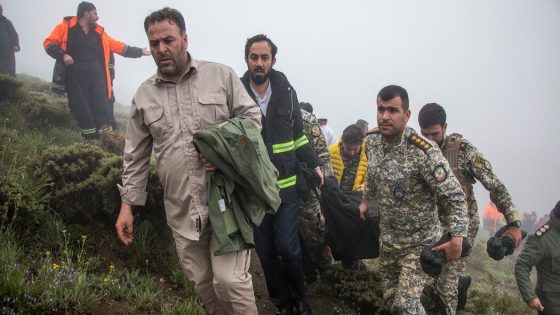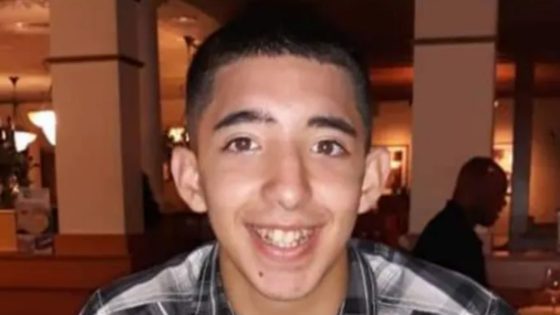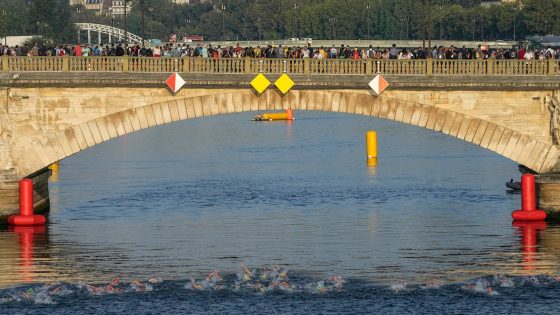Shortly before embarking on a fatal helicopter ride on Sunday, Iran’s president, Ebrahim Raisi, and his delegation of senior officials held a communal prayer. Someone suggested having lunch, but the president demurred, saying he was in a hurry to reach his next destination.
Mr. Raisi boarded the aircraft and sat by a window. The foreign minister, Hossein Amir Abdollahian, stopped for a picture with a crowd that was swarming the tarmac. He smiled and placed one hand over his chest while holding a brown briefcase in the other.
Around 1 p.m., a convoy of three helicopters took off from a helipad on Iran’s border with Azerbaijan, with the president’s craft in the middle. But about half an hour into the flight, the president’s helicopter vanished.
Calls to passengers on the president’s helicopter were met with silence until one answered. “I don’t know what happened,” Ayatollah Mohammad-Ali Al-Hashem said, sounding distraught. “I am not feeling well.” Two hours later, his phone, too, went silent.
As a frenzied 17-hour search unfolded, government officials began an aggressive effort to guard against possible threats from abroad and, especially, unrest at home, mindful of an uprising led by women and girls in 2022 that demanded the end of the Islamic Republic.
While Iran’s supreme leader, Ayatollah Ali Khamenei, was reassuring Iranians on national television that they need not fear any disruption to the country’s security, officials were scrambling. Iran placed its Armed Forces on high alert, worried that enemies like Israel or ISIS might carry out covert strikes. It directed media coverage of the crash, controlling the flow of information and banning any suggestions that the president was dead. The government deployed plainclothes security agents on the streets of Tehran and other big cities to prevent antigovernment protests or celebrations of Mr. Raisi’s death, and the cybersecurity units of the police and the Intelligence Ministry monitored posts by Iranians on social media.
This account of what happened in the hours after the crash was pieced together from the accounts of senior Iranian officials traveling with the president; reports and videos from state television; government statements; open-source reports and video footage; five Iranian officials, including two members of the Islamic Revolutionary Guards Corps; three Iranian diplomats; a former vice president; several Iranian journalists; and a photographer who was present at the crisis-management center near the crash and who participated in the search.
The president and a delegation of senior officials traveled earlier Sunday to Iran’s border with Azerbaijan to inaugurate a joint dam project. When the three helicopters carrying them took off, there was a dense overcast, videos published on state media showed.
Also on the helicopter carrying Mr. Raisi and Mr. Amir Abdollahian, the foreign minister, were Mr. Al-Hashem, who was the Friday prayer imam of the northern city of Tabriz; Malek Rahmati, the governor of East Azerbaijan Province; and Gen. Seyed Mehdi Mousavi of the Ansar unit of the Revolutionary Guards Corps, Iran’s equivalent of the Secret Service, who was the chief of presidential security. The helicopters followed a planned flight route but shortly after takeoff encountered a thick fog in a valley of rolling green mountains.
Mehrdad Bazrpash, the minister of transportation, and Gholam-Hossein Esmaili, the president’s chief of staff, were in the lead helicopter. It had just emerged from the fog when they noticed a commotion in the cockpit.
Mr. Bazrpash asked the pilot what was going on, he told state television in a recollection of those first hours. They had lost track of the president’s helicopter, and it was not responding to radio calls, the pilot told him, suggesting it might have made an emergency landing. The pilot turned around, Mr. Bazrpash said, circling the area several times, but the fog blocked visibility and descending into the valley was too risky.
The two helicopters eventually landed at a copper mine in the mountains in northwest Iran, 46 miles from the closest town. In a matter of hours, a modest office building there would be transformed into an ad hoc crisis-management center, with hundreds of officials, military commanders and even hikers and off-road motorcyclists, Azin Haghighi, a photographer from Tabriz who was at the center, said in a telephone interview.
On state television, Mr. Esmaili said he called the cellphones of Mr. Raisi, Mr. Amir Abdollahian, Mr. Al-Hashem and one other official. Nobody answered.
He dialed the pilot’s number, but it was Mr. Al-Hashem who finally answered.
“Where are you?” Mr. Esmaili asked, recounting the conversation. “What happened? Can you give us a sign to find your location? Can you see the others? Are they all right?”
“I’m in the middle of the trees,” he said. “I’m alone. I can’t see anyone.”
When Mr. Esmaili pressed him for more details, the cleric described being in a forest with burned trees. In subsequent calls, his voice began to fade, and he sounded more confused. After about two hours, he stopped responding.
Mr. Bazrpash called the national aerospace control center for the helicopter’s coordinates, but technicians there could provide only an estimate of the crash area, and because of the site’s remoteness, they could not trace phone signals.
The exact location remained elusive. There was no signal from the helicopter. Panic began to set in as officials on the other helicopters realized that the president’s aircraft had crashed violently and that Mr. Raisi, who was widely seen as a likely successor to the supreme leader, and others on board were either gravely injured or dead.
The officials notified Tehran and requested emergency search-and-rescue teams, but they took hours to arrive, slowed by the hazardous weather and narrow roads that snaked around the mountains, Mr. Bazrpash said in an interview with state television.
Mr. Bazrpash said that the officials in the presidential party did not wait for the emergency crews but set out themselves in cars with people from the copper mine. But amid fog, wind and rain, he said, they were forced to abandon the cars and walk to villages nearby, hoping the local people could help them find the crash site. The effort proved futile, he said, and they returned to the mine.
In Tehran, Mohammad Mokhber, the first vice president who is now the acting president, oversaw a scheduled cabinet meeting. Although he knew about the crash and the possibility that Mr. Raisi had died, he carried on with mundane government business and waited until the end of the meeting to break the news to the rest of the cabinet, according to Ali Bahadori Jahromi, the government spokesman.
Mr. Khamenei, the supreme leader, who had been informed of the accident immediately after officials established that the president’s helicopter was missing, called an emergency meeting of Iran’s Supreme National Security Council at his home, advising its members to maintain order and project strength, according to a member of the Guards Corps and a government official who were briefed on the meeting but were not authorized to discuss it publicly.
The Ministry of Culture and Islamic Guidance called media organizations and set guidelines for coverage, issuing a gag order against insinuating that the president and other officials might be dead, said four journalists in Iran who requested anonymity for fear of retribution.
The first reports, saying that the president’s helicopter had “made a hard landing,” appeared on state television in early afternoon. For hours, disinformation circulated on official and semiofficial news outlets, with some reports that Mr. Raisi was driving back to Tabriz or was safe and sound, or that passengers on the helicopter said they had all survived.
An Iranian businessman and a media analyst, both with large followings on social media, said in interviews that the Intelligence Ministry contacted them around 6 p.m. Sunday and told them to delete social posts about the crash. The intelligence wing of the Guards Corps arrested a person they said had posted inaccurate information about the president’s helicopter, Fars News reported on Thursday.
By around 11 p.m. Sunday, however, the Ministry of Culture and Islamic Guidance asked state media to switch to calling for prayers and told them to prepare for an official announcement in the morning.
Back at the mine, Gen. Hossein Salami, the commander in chief of the Guards, had taken command of the operation there, settling into a conference room where a large screen projected a 3-D map of the crash area.
“It was chaotic; everyone was on edge,” Mr. Haghighi, the photographer, said. “Search groups would go out in batches and return saying it was impossible to see anything. Inside the control center, people were shouting, running from room to room and desperate for news.”
Iran needed its advanced drones to locate the crash site, but they had been deployed to the Red Sea, so the country had to turn to Turkey, asking it for a drone, a statement from Iran’s Armed Forces said. Ultimately, though, an advanced Iranian drone returned from the Red Sea and found the crash site, the statement said.
At the first sign of light Monday, rescue teams headed out on foot. Mr. Haghighi, who accompanied one of them, said it took them an hour and half to hike up a steep mountain and then down through a muddy forest.
The first to reach the site, however, were the volunteer motorcyclists. Video shows one of them running through the trees, yelling, “Haj Agha, Haj Agha,” as he shouts for Mr. Raisi using a term of endearment. When he encounters the broken tail of the helicopter, the charred wreckage and luggage scattered on the ground, he wails, “Allah o Akbar, ya Hussein,” evoking God and a Shiite imam.
The helicopter had exploded in a ball of fire on impact, the Armed Forces said in a statement, later adding that a preliminary investigation showed no signs of foul play or bullets on the aircraft. But many officials have questioned whether security protocols were observed and why the president traveled by air under stormy conditions.
The bodies of Mr. Raisi and Mr. Amir Abdollahian were discovered near the debris. They were both burned beyond recognition, according to the three officials in Tehran, two members of the Guards and Mr. Haghighi, who saw the bodies.
Mr. Raisi was identified by his ring, and Mr. Amir Abdollahian by his watch.
Source Agencies




